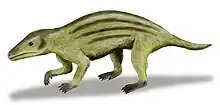Priacodon
Priacodon is an extinct genus of Late Jurassic eutriconodont mammal from the Alcobaça Formation of Portugal and the Morrison Formation of the midwestern United States. It is present in stratigraphic zones 4–6 of the latter.[1] The genus contains four known species: Priacodon ferox, Priacodon fruitaensis, Priacodon lulli and Priacodon robustus.
| Priacodon Temporal range: | |
|---|---|
 | |
| Lower jaw (LACM 135530) of P. fruitaensis, Natural History Museum of Los Angeles County | |
| Scientific classification | |
| Domain: | Eukaryota |
| Kingdom: | Animalia |
| Phylum: | Chordata |
| Class: | Mammalia |
| Clade: | †Eutriconodonta |
| Family: | †Triconodontidae |
| Genus: | †Priacodon Marsh, 1887 |
| Type species | |
| †Priacodon ferox Marsh, 1880 | |
Jaw and teeth
A study on the jaw and teeth of Priacodon suggests that eutriconodonts, while specialised towards carnivory, had a more passive jaw roll than modern therian carnivores. It also demonstrates that embrasure occlusion was present in all eutriconodonts, as opposed to one-to-one patterns as previously assumed for the family Triconodontidae.[2]
See also
References
- Foster, J. (2007). "Appendix." Jurassic West: The Dinosaurs of the Morrison Formation and Their World. Indiana University Press. pp. 327–329.
- Jäger, Kai R. K.; Cifelli, Richard L.; Martin, Thomas (2020). "Molar occlusion and jaw roll in early crown mammals". Scientific Reports. 10 (1): 22378. Bibcode:2020NatSR..1022378J. doi:10.1038/s41598-020-79159-4. ISSN 2045-2322. PMC 7759581. PMID 33361774.
Bibliography
- Foster, J. (2007). Jurassic West: The Dinosaurs of the Morrison Formation and Their World. Indiana University Press. 389pp.
This article is issued from Wikipedia. The text is licensed under Creative Commons - Attribution - Sharealike. Additional terms may apply for the media files.



